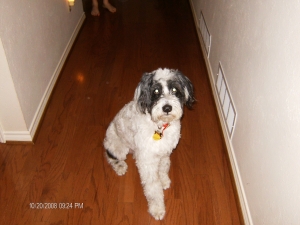What is Behavior Modification?
Each week I receive dozens of calls from dog owners who ask me how to resolve the various problem behaviors that their dogs are exhibiting. Almost always, they ask when the next obedience class is and how to sign up. I then explain to them that while obedience training is a very important factor in raising a well-mannered, manageable companion, obedience training is not the cure for every behavioral problem. What their dogs really need is a Behavioral Modification program. Behavior Modification is the means to resolving behavioral issues. Obedience training cannot accomplish behavior modification. In fact, teaching obedience commands to solve a behavioral problem can and often does get in the way of helping the dog resolve his or her problem. For instance, if a dog is stressed or anxious in a given context, forcing him to perform some obedience exercise sit, lay down, whatever, can add to the stress or anxiety. That, in turn, does nothing to change the stress or anxiety he may have within that context and leaves the dog with the same behavioral problem. Or, if your dog is doing something you do not like, having him down-stay may stop the behavior at that time, but again, it does nothing to address the behavior or its possible cause.
Obedience training can give you the control needed to prevent a number of potential life threatening situations. For example: If the door is left open and you see your dog letting himself out, you can safely call him back using your recall command. Or if your dog slips his collar, you can command him to sit (he can’t run off when he’s sitting) to get the collar back on, etc. Obedience Training can also serve to strengthen the bond between you. It builds understanding, mutual respect, and teaches you how to “speak dog.”
Although the benefits of obedience training are many, it has little to do with behavior modification. For example, if your dog is in the habit of running off, your recall command may stop and return the dog to you, however, the recall command does nothing to address the running off in the first place. Or, if your dog is aggressive, you may be able to “call the dog off” but again, it does nothing to address the aggression or its possible cause. If your dog is fearful of something and you can get him to sit or lay down, it will not change the dog’s fear response.
Behavior modification utilizes the behaviors differently. Significantly, behavior modification programs address the underlying reasons for the problem behaviors. This is done by identifying, analyzing and appropriately reconditioning the dog’s out ward physical signs which indicate the dog’s internal physiological and psychological state. It is the underlying physiological and psychological state that behavior modification alters and which obedience training cannot address. Although there are similarities among obedience training and behavior modification, behavior modification differs in goal, outcome and reward structure. It IS hard work and there are no quick fixes.
The vast majority of behavior problems that are presented to me are the result of inappropriate communication, over-permissiveness (spoiling) and/or anthropomorphism (treating the dog as it were a human). Other times, problems are simply the result of unfortunate relationship dynamics. Fortunately, most of these problems are resolvable with some education and work on the part of the owner. The owner must first understand that dogs come to us genetically predisposed to behave in certain ways. Some dogs have higher propensities to be aggressive, fearful, “dominant” subordinate, etc. The level at which these behaviors present themselves depends on many factors. So, how we love, raise and interact with our dogs will have a huge impact on how the dog develops and what behaviors grow and become problematic.
There are a number of considerations behavior specialists look at when dealing with behavior problems. First, we make sure the dog is healthy; we want to rule out any medical factors. Second, we check the dog’s environment; we want to rule out any environmental factors. For example, we look at the relationship between the dog and all family members. We take into consideration the dog’s breed or mix and any predisposition the dog may have toward a particular set or pattern of behavior.
Case History: Ralph’s Story Ralph is a 2 year old miniature Dachshund. His owner, a single female presented him to me with a problem greeting people that came to their house. He was “very aggressive.” Ralph had everything he ever wanted, he slept with his “Mom” sat in her lap, barked at her for attention and other things, had food whenever he wanted it and clearly was the ruler of his domain.
Ralph developed a strong territorial aggression problem. Anyone and everyone was a threat (in his mind) to his resources and territory. Ralph’s owner called his Veterinarian to ask for advice. She was told that Ralph needed “obedience training” and then referred her to a “trainer.” The advice she received from the trainer shocked her. She was told to “hit Ralph on the nose with a rolled up magazine until he stopped barking and carrying on.” She was also advised that if the hitting did not work, she was not hitting hard enough and that it may be necessary to hit Ralph hard enough to make his nose bleed. Fortunately for Ralph, she could not bring herself to do this. The unfortunate thing is that this is typically the kind of advice people are often given by others.
After evaluating and gathering a history on Ralph, I outlined a behavior modification program and worked with Ralph and his owner over an eight week period of time and am happy to report that the two of them are doing great! Ralph is now excepting of others and no longer threatens and displays when someone comes for a visit or when they are out for walks. Once we got Ralph to relax we were able to implement the program with great success. The punishment advice Ralph’s owner received from the trainer would have only made the situation worse and done absolutely nothing to address the underlying cause of Ralph’s behavior, which in this case, was the fact that Ralph thought he ruled the roost. (I feel the advice was very irresponsible given the fact that the “trainer” never took the time to evaluate Ralph or thoroughly interview his owner). Ralph’s owner learned how his problem behavior came to be and they then learned how to change it without abusing Ralph in the process. We also did some obedience training with Ralph and he has done very well with that as well. I would like to point out that Ralph’s owner deserves the credit for Ralph’s turnaround. She realized there was a problem, made the commitment and put in the time necessary to achieve success.
When addressing a behavior problem, we determine what kind of behavior we are dealing with. For example if we are dealing with a behavior that is not harmful to the individual or others, we can employ operant conditioning techniques such as: Extinction, Differential Reinforcement, and Antecedent Control just to name a few. If we are dealing with aggression (as with Ralph) or fearful behaviors, we would employ Classical Counter-Conditioning and Desensitization.
In conclusion, to solve behavior problems one must employ a sound Behavior Modification program, provided by a qualified behaviorist, or behavior specialist. Obedience training, although important, has little to nothing to do with behavior modification and should not be utilized to try and solve behavior problems. As we saw with Ralph, merely punishing the dog will do nothing to address the underlying reasons/causes or the behavior itself and may fail or make the problem worse. But, as we also saw with Ralph, if you understand and work to address the root of the problem in an educated, consistent, clear, and humane manner, you will be rewarded with an enjoyable companion for years to come.
Good Behavior Tips include Good Management
To be successful in raising and training your dog, good management is essential. Good management means planning ahead to set your dog up to be right and then POSITIVELY REINFORCING your dog when he is doing the behavior you like. My favorite example of what good management can do is the call I received recently. The caller was the owner of a 5 year old male dog whom he had owned since puppyhood. In asking the caller the litany of questions that I must ask to get as much background as possible, I discovered that the dog had many issues that should be addressed. However, the caller was interested in correcting only one persistent problem; that of the dog stealing food off of the kitchen counters.
He, the caller, wanted me to “train” his dog so he wouldn’t steal food from the counter. I explained to him that this is not necessarily a training issue, but rather a management problem. Now, I suspect that many of reading this have already figured it out. That’s right, DON’T LEAVE FOOD OUT ON THE COUNTER. It is simple, remove the reward, in this case the food, and the behavior goes away. The other option is to prevent the dog from having access to the kitchen. This is clearly a management issue. Through better management the caller was able to correct this problem over the course of a couple of weeks.
Behavior is governed by consequences. The consequences of getting up on the counter was receiving the food. By removing the food, there is no consequence (positive or negative) and the behavior becomes extinct. Oh yes, it took a little time, but it was worth it. Dogs do what works (for them).
In the past the caller had been using ineffective punishment to try to “train” the dog not to steal food: baiting the counter and trying to “catch the dog in the act” and then punishing it. What the dog learned (as most will) is to only steal food when the likelihood of getting caught was slim to none. In other words, when the owner was gone. So, when he returned home to find the evenings pot roast gone, he would scold and punish the dog. The dog had NO idea why he was being punished. This belated punishment resulted in the breakdown of their relationship, thus leading to several other problem behaviors.
This guy learned a new, more effective way to communicate to his dog. They attended classes and have since moved on to a very rewarding partnership.
Hello world!
Welcome to WordPress.com. This is your first post. Edit or delete it and start blogging!


